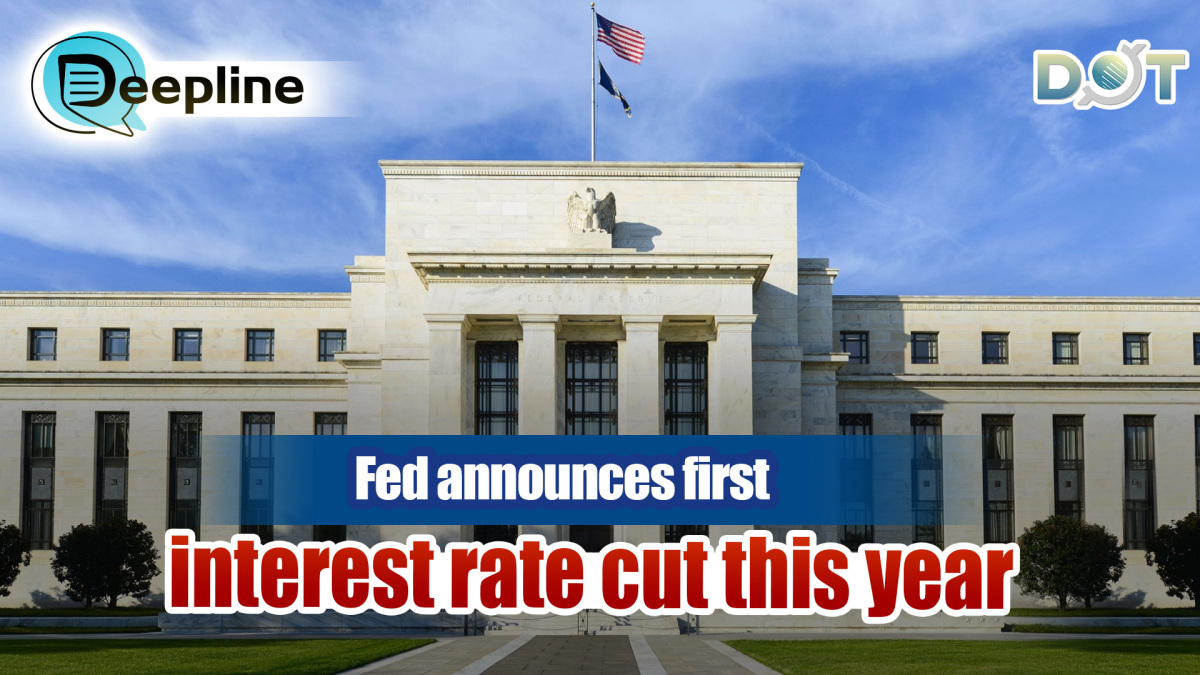
According to CCTV News, on Sept. 17, the U.S. Federal Reserve concluded its two-day monetary policy meeting and announced a 25-basis-point cut in the federal funds rate target range to between 4.00% and 4.25%. This marks the Fed's first rate cut in 2025 and follows three rate cuts in 2024. Upon the news, investors began assessing the Fed's rate decision and projections, triggering immediate reactions in the U.S. stock market. Meanwhile, concerns have resurfaced regarding the Fed's ability to maintain its independence.
Slowing Job Growth and Shift in Risk Balance Prompt Fed Rate Cut
The Federal Open Market Committee (FOMC), the Fed's policymaking body, stated in a release on Sept. 17 that U.S. economic activity growth slowed in the first half of the year, job gains moderated, the unemployment rate edged up, and inflation rose and remained elevated to some extent. The Committee aims to achieve maximum employment and 2% inflation over the long term. However, uncertainties regarding the economic outlook remain high. The Committee noted the risks to its goals and judged that the employment risks have increased. To support the Committee's objectives and in light of the shifted risk balance, it decided to lower the federal funds rate target range by 25 basis points to 4.00%–4.25%.
Fed projections indicate an additional 50 basis points in rate cuts by year-end, followed by 25 basis points each year over the next two years. Additionally, the Fed released its latest economic outlook on Sept. 17, with the "dot plot" showing that among 19 Fed officials, nine expect two more rate cuts this year, two anticipate one more cut, and six foresee no further cuts.
Powell: "A Tricky Situation"
Following the monetary policy meeting on Sept. 17, Fed Chair Jerome Powell held a press conference at the Fed headquarters. Powell stated, In the near term, inflation risks are tilted to the upside, and employment risks are tilted to the downside—this is a tricky situation. When our goals conflict in this way, our framework calls for us to balance the two sides of our dual mandate. With the downside risks to employment having increased, the balance of risks has shifted.
Mixed Closing for U.S. Stocks
After the Fed cut its benchmark interest rate, U.S. stocks closed mixed. The Dow Jones Industrial Average rose 260.42 points, or 0.57%, after briefly turning negative earlier. The S&P 500 fell 0.1%, and the Nasdaq Composite dropped 0.33%. Additionally, following the Fed's announcement, the U.S. dollar index initially fell 0.4% but erased losses and rose 0.3% after Powell's press conference. U.S. Treasury yields initially declined but later rose after Powell emphasized inflation risks.
U.S. media reported that while stocks had rallied in recent weeks on expectations of a Fed rate cut, the outcome was insufficient to trigger significant market volatility. A strategist at J.P. Morgan Asset Management noted that the U.S. labor market is weakening, prompting the Fed to deem a rate cut appropriate, but they are not cutting rates aggressively due to ongoing inflation concerns. An economist at Oxford Economics stated, "The accompanying 'dot plot' reveals significant divergence within the Committee on whether further rate cuts are warranted this year."
Since taking office in January this year, U.S. President Donald Trump has consistently pressured the Fed to cut interest rates.
White House vs. Fed: Escalating Tensions!
According to a Reuters report from Washington on Sept. 15, the U.S. Senate narrowly approved Stephen Miran's appointment to the Federal Reserve Board on Sept. 15, expanding President Donald Trump's influence over the world's most important central bank and giving his top economic advisor one of the 12 votes on interest rate decisions ahead of a critical policy meeting.
The Senate vote on Sept. 15, controlled by Republicans, was 48–47, largely along party lines. This marked the final step in a swift process that began in August when Adriana Kugler unexpectedly resigned from the Fed Board, creating a vacancy in the seven-member body and allowing Trump to appoint someone more inclined toward rate cuts.
While Fed Board confirmations typically take months, Miran's approval was completed in less than six weeks.
Pending paperwork and the oath of office, Miran will participate in the U.S. central bank's two-day policy meeting starting on Sept. 16. Fed policymakers are expected to approve a 0.25-percentage-point rate cut at the conclusion of the meeting on Sept. 17 to support the weakening labor market.
As head of the White House Council of Economic Advisers, Miran has repeatedly expressed confidence that Trump's high import tariffs will not cause inflation and that the president's other policies, including crackdowns on immigration, will alleviate broad price pressures by reducing housing demand.
As the newest member of the Fed Board, Miran's responsibilities extend beyond voting on interest rates; Board members typically serve on multiple committees, overseeing areas such as U.S. financial regulation, community banking, and staffing and budget decisions for the central bank system and its 12 regional banks.
Miran will retain his role at the White House. Additionally, he will serve as a Fed Board member until Jan. 31 next year. However, if a successor for his Fed seat is not selected or approved, he could remain indefinitely.
Democrats have criticized this arrangement, calling him Trump's "puppet," a claim Miran denies.
During the Fed meeting on July 29–30, Michelle Bowman and Christopher Waller, both appointed by Trump during his first term, dissented and supported more accommodative policies. Analysts say that since then, weaker-than-expected labor market data may lead them to dissent again in September, advocating for a larger rate cut than the 0.25 percentage points widely expected by financial markets.
No three Fed Board members have dissented simultaneously since 1988.
Court Rules Fed Governor Lisa Cook Can Retain Position
According to an AP report from Washington on September 15, an appeals court ruled on Sept. 15 that Lisa Cook can continue serving as a Federal Reserve Board member, rejecting President Donald Trump's attempt to remove her from office ahead of a critical vote on interest rates.
The Trump administration is expected to quickly appeal to the Supreme Court, representing a last-ditch effort to oust Cook before the Fed meeting. Meanwhile, Cook's lawsuit seeking to permanently block her removal must still proceed through the courts.
The White House's move to remove Cook marks an unprecedented effort to reshape the seven-member Fed Board, which is designed to be largely insulated from day-to-day politics. No sitting Fed Board member has ever been removed by a president in the central bank's 112-year history. The ruling came just before the Fed's rate-setting committee began its two-day meeting on the 16th. Senate Republicans have already approved Trump's nomination of Stephen Miran to fill the vacancy on the Fed Board.
Trump attempted to dismiss Cook on Aug. 25, but a federal judge ruled last week that the removal was unlawful and reinstated Cook.
The case threatens to erode the Fed's long-standing political independence. Economists favor an independent central bank, as it is more likely than elected officials to take unpopular actions, such as raising interest rates, to combat inflation.
(Source: CCTV News, AP, Reuters, Fed | English Editor: Liu Yu)
Related News:
Deepline | Americans remain at top of 'imperial menu'
Deepline | What TIME's blood-red cover says about America's future




















Comment